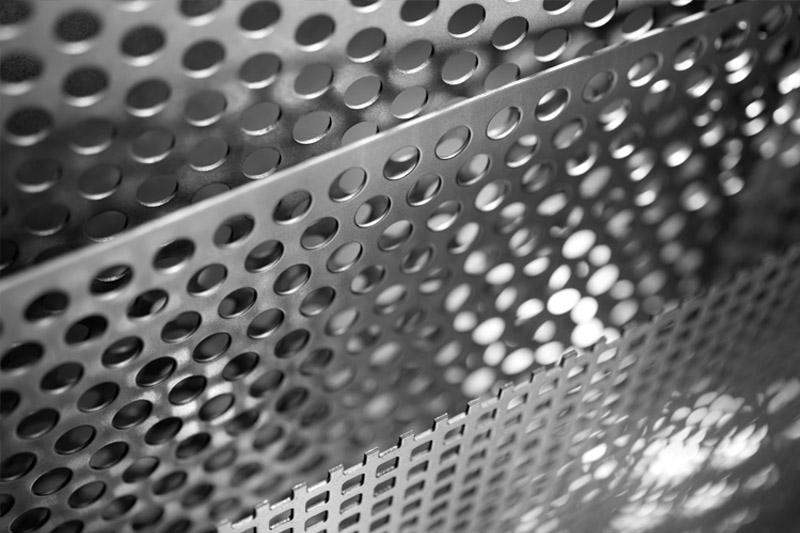What is a Perforated Sheet?
A perforated sheet is a metal product that undergoes a specific process known as metal perforation which creates a multifaceted item ideal for many applications like industrial, architectural, and decorative uses, mechanically explaining the process includes punching or stamping to create a series of holes, slots, or ornamental patterns, perforated sheet applications are varied in range they can be used in ventilation, filtration, aesthetic facade designs and acoustic panels.

Common Materials Used in Perforated Sheets
Perforated sheets come in diverse materials to meet different applications with many environmental conditions:
- Stainless Steel Perforated Sheet - is distinguished by its high resistance to corrosion, making it ideal for harsh environments.
- Aluminum Perforated Sheet - it is lightweight and more resistant to rusting over time, mainly suitable for outdoor and marine applications.
- Carbon Steel - a special material with strength and cost-effectiveness, mostly ideal for industrial and structural use.
- Copper & Brass - due to their attractiveness in finishes, they are used for decorative purposes
Standard Sizes and Thickness Options
Perforated sheet thickness can largely vary depending on the application itself and material type requested. Common thicknesses come in different ranges from 0.5 mm to 5 mm for most uses.
- Standard sheet sizes are typically available as 1,000 x 2,000 mm or 1,250 x 2,500 mm, but custom sizes are considered according to various needs.
- Hole sizes and patterns are available in many shapes like round, square, or slotted, and as for spacing to control airflow, drainage, and visibility they can be customized according to all needs.
Applications of Perforated Sheets
- Architectural Uses - For facades, ceilings and partition walls, decorative perforated sheets are considered for the versatility they provide.
- Industrial Uses - For filtration, soundproofing and ventilation, industrial perforated metal is utilized due to solidity and the robustness it provides.
- Automotive & Aerospace - For engine covers and grilles, lightweight and strong materials can be opted for due to its compositions and textures.
- Furniture and Design - Perforated panels are being widely used for modern furniture, screens and more often in lighting fixtures.
- Construction - As for building, perforated sheet is employed here mainly for stair treads, balustrades, and sunscreens.
Advantages of Using Perforated Sheets
- Lightweight & Strong - The best option that combines durability with easy handling.
- Ventilation & Filtration - it is ideal to get adequate protection, airflow and drainage due to its openings.
- Aesthetic Appeal - it is strikingly modern in designs with customization in patterns.
- Noise Reduction - it is a perfect match for acoustic panels to absorb as much sound as possible.
- Corrosion Resistance - Stainless steel and aluminum come as the best options to resist rusting conditions and weather damage.
Customization Options for Perforated Sheets
- Hole Shapes & Sizes - They come in many variations like round, square, hexagonal, or slotted patterns.
- Material Type - The standard bundle includes steel, aluminum, and copper it all depends on durability and aesthetic needs required to be met.
- Finishes - in order to improve resistance and appearance we can apply many processes like powder coating, anodizing, and polishing
- Sheet Size & Thickness - Diverse dimensions can be customized to suit many different load and application needs.
How to Choose the Right Perforated Sheet
- Identify the Purpose - it is very important to know the need exactly if you want it for an industrial use, you can opt for stronger materials like steel, if it is for decorative purposes, aluminum or brass are preferred.
- Evaluate the Environment - For example corrosion-resistant materials are used for outdoor applications as weather can be harsh in some regions.
- Consider Load & Strength - Perforated sheet thickness should be matched to the load requirements.
- Pattern & Hole Size - Choose the smaller holes for filtration and the larger ones for airflow and more visibility.
- Aesthetic & Functionality - For architectural applications we can combine function and style to achieve two purposes.
Conclusion
At ANB Metal, we provide perforated sheets with versatile materials and we ensure strength, design flexibility and functionality, Customization is also available at our facility with various material choices, perforated sheet applications are essential nowadays for both industrial and architectural projects and cannot be avoided.